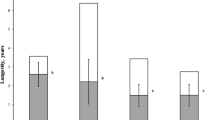Summary
The reproductive rates of about 50 species of Australian rodents were studied by calculating allometric equations for the relationships between female body weight, litter size, length of gestation and weaning periods as well as age of sexual maturity.
Members of the subfamily Hydromyinae, which invaded Australia 5–10 million years ago, are characterised by small litters, long gestation and weaning periods and late maturity. The opposite is true for the Murinae (Rattus and Mus) which invaded Australia during the Pleistocene. Among the species of this latter group, those which invaded earlier have reproductive rates closer to the old invaders, while those which arrived with the Europeans during the last 200 years have the highest reproductive rates.
Possible reasons for the low reproductive rates of Australian rodents are discussed. It is concluded that the rain forest origin of the hydromyinids is one of the factors responsible for their low reproductive rate. They maintained this rate to the present time because of the unpredictability of the climate and the low productivity of many Australian habitats.
Similar content being viewed by others
References
Baverstock PR, Watts CHS, Hogarth JT, Robinson AC, Robinson JF (1977) Chromosome evolution in Australian rodents II. The Rattus group. Chromosoma 61:227–241
Blueweiss L, Fox H, Kudzma V, Nakashima D, Peters R, Sams S (1978) Relationships between body size and life history parameters. Oecologia (Berlin) 37:257–272
Braithwaite LW, Dudzinski ML, Turner J (1983) Studies on the arboreal marsupial fauna of eucalypt forest being harvested for woodpulp in Eden, N.S.W. II. Relationship between the fauna density, richness and diversity, and measured variables of the habitat. Aust Wildl Res 10:231–247
Breed WG (1979) The reproductive rate of the hopping-mouse Notomys alexis and its ecological significance. Aust J Zool 27:177–194
Cockburn A, Braithwaite W, Lee AK (1981) The response of the heath rat Pseudomys shortridei to pyric succession: A temporally dynamic life-history straegy. J Anim Ecol 50:649–666
Cockburn A, Lee AK, Martin R (1983) Macrogeographic variation in litter size in Antechinus (Marsupialia: Dasyuridae). Evolution 37:86–95
Eisenberg JF (1981) The Mammalian Radiations. The University of Chicago Press, Chicago and London
Eisenberg JF, Isaac DE (1963) The reproduction of heteromyid rodents in captivity J Mammal 44:61–67
Fleming TH (1977) Growth and development of two species of tropical heteromyid rodents. Am Midl Nat 98:109–123
Happold M (1976) Reproductive biology and developments in the conilurine rodents (Muridae) of Australia. Aust J Zool 24:19–26
Klomp H (1970) The determination of clutch egg size in birds: a review. Ardea 58:1–24
Lack D (1968) Ecological adaptations for breeding in birds. Methuen, London
Lee AK, Baverstock PR, Watts CH (1981) Rodents — The new invaders. In: Keast A (ed) Ecological Biogeography of Australia. Dr. W. Junk, Publishers. The Hague pp 1523–1553
Leeper GW (1970) Climates. In: Leeper GW (ed) CSIRO, Melbourne The Australian Environment pp 12–20
Lindstedt SL, Calder WA (1981) Body size, physiological times and longevity of homeothermic animals. Quat Rev Biol 56:1–161
Millar JS (1977) Adaptive features of mammalian reproduction. Evolution 31:370–386
Nix H (1982) Environmental determinants of biogeography and evolution in Terra Australis. In: Barker WR, Greenslade PJM. Evolution of the Flora and Fauna of Arid Australia. Peacock Publ pp 47–65
Noordwijk AJ van, Balen JH van, Scharloo W (1980) Heritability of ecologically important traits in the great tit. Ardea 68:193–203
Olsen PD (1983) Water-rat, Hydromys chrysogaster. In: Strahan R (ed) The Australian Museum Complete Book of Australian Mammals. Angus and Robertson, Sydney pp 367–368
Russel EM (1982) Patterns of parental care and parental investment in marsupials. Biol Rev 57:423–486
Sacher GA, Staffeldt EF (1974) Relation of gestation time to brain weight for placental mammals: Implications for the theory of vertebrate growth. Am Nat 108:593–615
Smith AP, Lee AK (1984) The evolution of strategies for survival and reproduction in possums and gliders. In: Smith AP, Hume ID (eds) Possums and Gliders Aust Mamma Soc, Sydney
Strahan R (1983) The Australian Museum Complete Book of Australian Mammals. Angus and Robertson, Sydney
Walker D (1972) Bridge and Barrier: The Natural and Cultural History of Torres Strait. Aust Natn Univ Press, Canberry
Watts CHS, Aslin HJ (1981) The Rodents of Australia. Augus and Robertson, Sydney
Western D (1979) Size, life history and ecology in mammals. Afr J Ecol 17:185–204
Western D (1983) Production, reproduction and size in mammals. Oecologia (Berlin) 59:269–271
Yom-Tov Y (1983) Life history tactics in two species of desert snails. J Arid Environ 6:39–41
Author information
Authors and Affiliations
Rights and permissions
About this article
Cite this article
Yom-Tov, Y. The reproductive rates of Australian rodents. Oecologia 66, 250–255 (1985). https://doi.org/10.1007/BF00379862
Received:
Issue Date:
DOI: https://doi.org/10.1007/BF00379862




